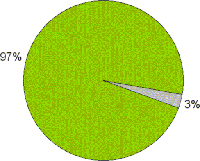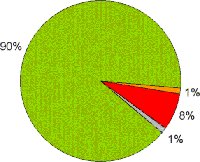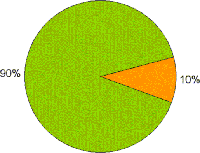
Third Analytical Summary
![]() de Hervé Maillot, Allié. France
, 8 de junio de 2005
de Hervé Maillot, Allié. France
, 8 de junio de 2005
Somewhat more than a month after the the Web site was set up for this consultation, the following elements have appeared distinctly:
![]() The answers are massively favorable to the Constituent Charter project with total
approval at 87 percent (the rest of the answers being more-or-less critical but
never in complete opposition).
The answers are massively favorable to the Constituent Charter project with total
approval at 87 percent (the rest of the answers being more-or-less critical but
never in complete opposition).
![]() The number of answers is low in proportion to the number of persons addressed,
with participation at less than 2 percent.
The number of answers is low in proportion to the number of persons addressed,
with participation at less than 2 percent.
![]() Expressed positions of disagreement, incomprehension, and/or questioning are both
not very numerous and extensively shared by those who express them (between 10 and
22 percent of participants, depending on the question).
Expressed positions of disagreement, incomprehension, and/or questioning are both
not very numerous and extensively shared by those who express them (between 10 and
22 percent of participants, depending on the question).
1 - Approval of the project: the idea of the Alliance and the Charter project deeply reflect what participants feel. All of them express the need and the emergency to come together and interconnect to work on the emergence of alternatives to the evolution of the world. The answers show how much the finding, rejection, and conviction mentioned in the paragraph "Objectives of the Alliance" of the Charter proposal, on which the Allies’ involvement is actually based, are, in fact, the finding, rejection, and conviction of the participants. The same convergence of views applies to the nature of the Alliance. Five of the seven aspects describing what the Alliance is are in perfect keeping with the words of Allies, friends, and associates. Only the points dealing the vision of a global community to be built, on the one hand, and on the other hand the matrix, or nervous center of the Alliance that is represented by the Web site are problematic (see Point 3 below).
2 - The very low participation rate in the consultation: The number of answers raises questions and begs the issue of their representativeness. An outside look cannot viably consider this question through an equiponderance of the answers and the silences. It is probably necessary to ponder the answers and absence of answers according to the links to the Alliance of the persons who were addressed and of their level of involvement in the collective process/project of the Alliance.
3 - Expressions of disagreement, incomprehension, questioning: These reveal and illustrate to varying degrees "the specific contradictions that need to be overcome by the Alliance as it moves out of its first stage" (described in Paragraph 4 of the document on the position of the FPH). They seem to indicate that the arbitrations and/or innovations proposed by the Charter to solve these contradictions do not meet the expectations of those who express them.
3.1 - On the differences/divergences of motivation among the Allies. We observe a cleavage between a structuring vision calling to invest in the organizational and operational and an acting,or even activist vision, polarizing focusing on the operational. The cleavage is illustrated by semantic oppositions: abstract/tangible, future/present, global/local, thinking/action. It is in a way as if some, seen as favoring a methods office, were not in accordance with others, perceived as wishing to concentrate on the field. In any case, the call for "results" is collective. Some speak of pressure to be exercised on "decision makers" and even of lobbying actions. Finally, some of the divergences have to do with the issue of building a global community: a preliminary objective for some, the final result of the active construction from the local to the global for others. It should be noted that no answer considers these two approaches as simultaneous and complementary.
3.2 - On the informal nature of the Alliance. A point on which a number of Allies agree is that of the deficient readability and visibility of the Alliance, its absence of a communication strategy, its distance from the media. The desire to institutionalize the Alliance so it may weigh in one way or another on the international bodies is clearly expressed. But other participants favor the openness and absence of a "common voice" that characterize the Alliance.
3.3 - On the relations between the FPH and the Alliance. For many participants, the FPH and the Alliance are not dissociated. The FPH is assigned a unique Ally status and particular power. This poses a problem for a number of Allies, when their objectives, the missions that they set out for themselves, and the strategic choices that they call do not match the Foundation’s concerns and guidelines. Some participants expect the Alliance to be not only a place for sharing and a pool of ideas but also an instrument of continued support (including financial) for Allies involved in action, which refers to the wish for the backing of specific, thematically and geoculturally circumscribed projects.
3.4 - On the groups and follow-up committees and the facilitation of the Alliance. No real disagreement on this subject. Only some questions and requests for clarification. See the qualitative summary of May 11.
3.5 - On the web and its use. The importance of the Internet in the collective process that is the Alliance seems to exclude the fact that (many?) Allies do not have the needed technology. One answer recalls that two billion human beings have no access to electricity.
GRÁFICOS CUANTITATIVOS
![]()
|
||
Antes de reaccionar a esta síntesis, le animamos por favor a enviarnos previamente sus respuestas al cuestionario si no lo ha hecho ya.
TRADUCCIÓN
- français
- Español
Otras síntesis
 Primera síntesis |12 de mayo de 2005 |
Primera síntesis |12 de mayo de 2005 |
 Secunda síntesis |20 de mayo de 2005 |
Secunda síntesis |20 de mayo de 2005 |
 Cuarta síntesis |4 de julio de 2005 |
Cuarta síntesis |4 de julio de 2005 |
 Quinta síntesis |10 de agosto de 2005 |
Quinta síntesis |10 de agosto de 2005 |
 Sexta Síntesis |13 de septiembre de 2005 |
Sexta Síntesis |13 de septiembre de 2005 |
 Informe definitivo sobre el proyecto de Carta constitutiva para la Alianza por un mundo responsable, plural y solidario |6 de diciembre de 2005 |
Informe definitivo sobre el proyecto de Carta constitutiva para la Alianza por un mundo responsable, plural y solidario |6 de diciembre de 2005 |
- Alianza para un mundo responsable, plural y solidario -
- Fundación Charles Léopold Mayer para el progreso del Hombre -





